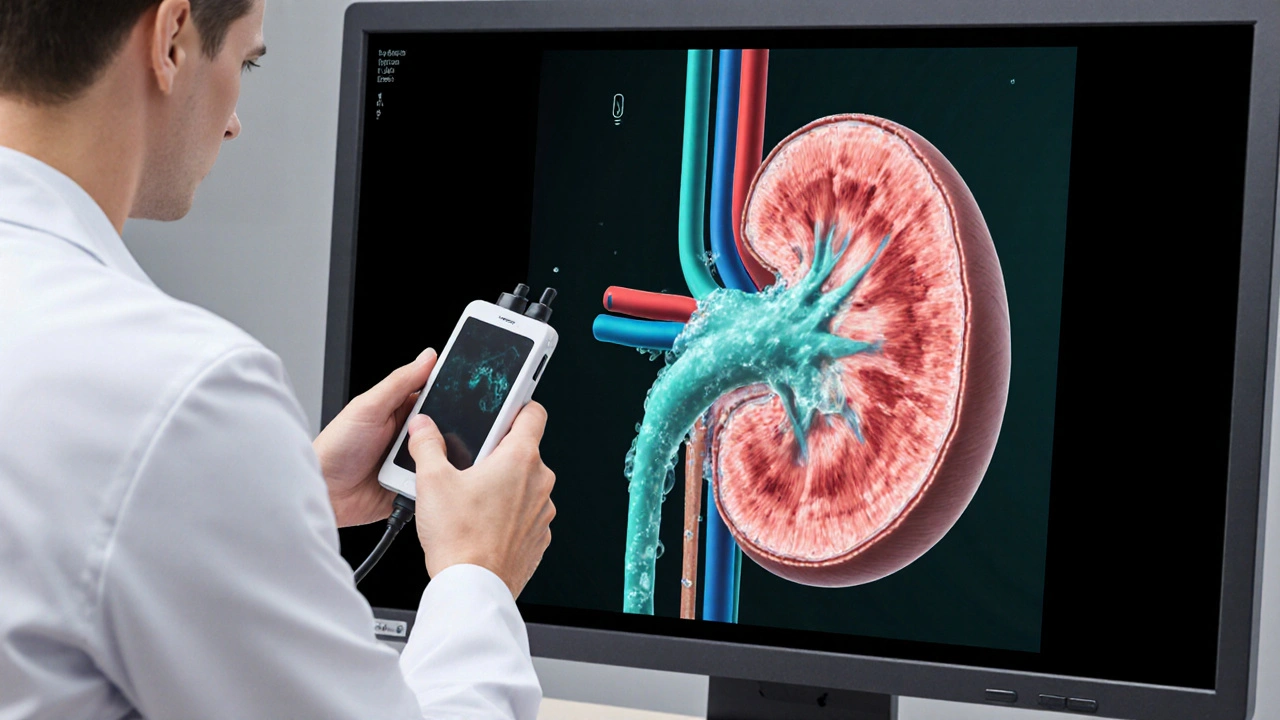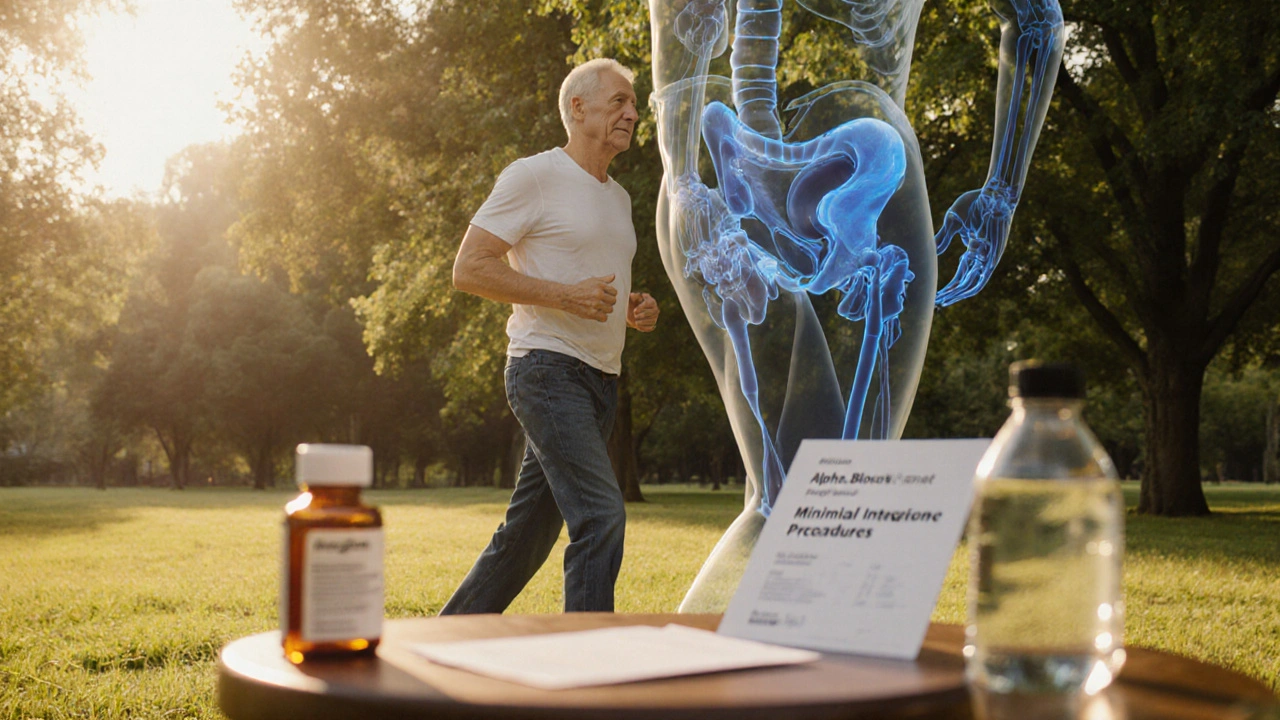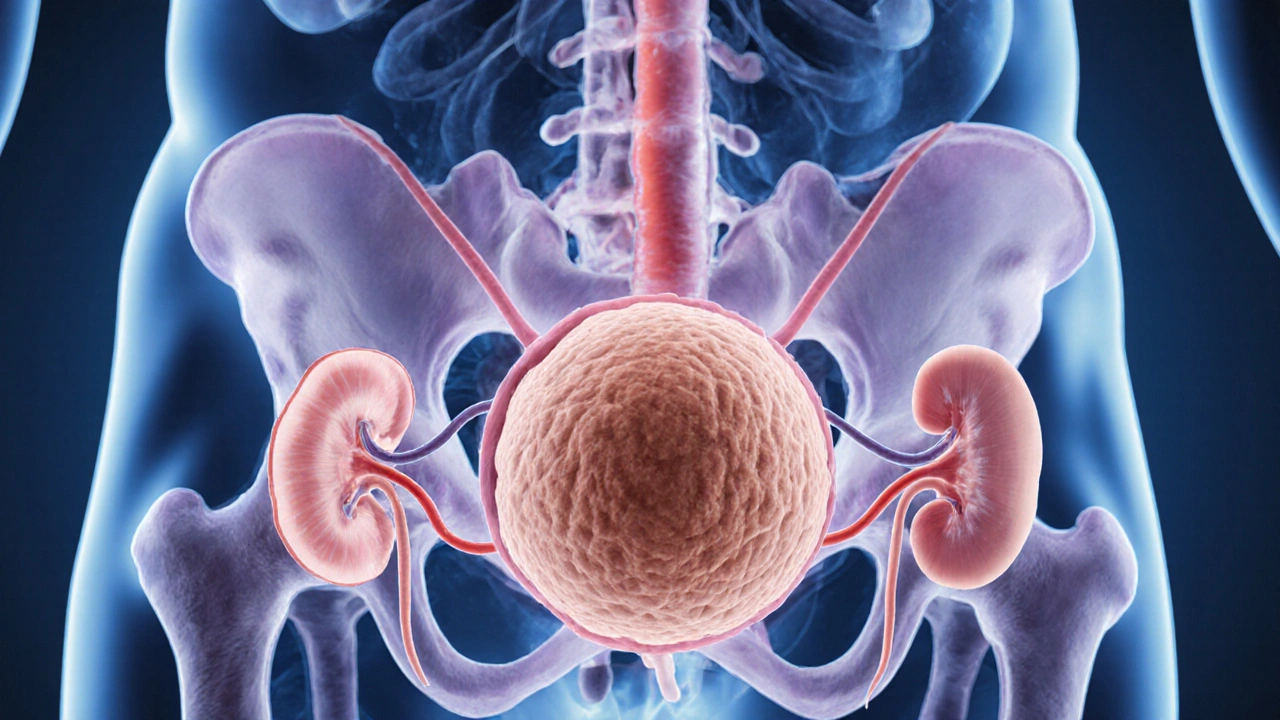BPH Kidney Function Calculator
Kidney Function Impact Calculator
Estimate how BPH treatment may impact your kidney function over time based on clinical data.
Imagine waking up with a nonstop urge to use the bathroom, only to learn that the pressure building in your pelvis might be damaging the very organs that filter your blood. That link between an enlarged prostate and kidney health is real, and understanding it can help you catch problems early.
What is Benign Prostatic Hyperplasia?
Benign Prostatic Hyperplasia is a non‑cancerous enlargement of the prostate gland that occurs in most men after the age of 40. The prostate, a walnut‑sized organ located just below the bladder, wraps around the urethra, the tube that carries urine out of the body. As the gland grows, it squeezes the urethra and can interrupt the smooth flow of urine.
Key Players in the Urinary‑Renal System
To see how BPH can affect kidneys, it helps to know the main structures involved:
- Prostate gland - the organ that enlarges in BPH.
- Bladder - a muscular sac that stores urine before you void.
- Urethra - the channel that runs through the prostate and carries urine out.
- Kidneys - paired filters that remove waste and excess fluid from the bloodstream.
- Ureter - tubes that drain urine from each kidney into the bladder.
When any part of this line gets blocked, pressure can travel backward, turning a simple flow problem into a renal concern.
From Prostate Enlargement to Urinary Retention
As the prostate expands, two mechanical issues arise:
- Partial obstruction: The urethra becomes narrowed, making it harder for urine to exit. This results in a weak stream, frequent trips to the bathroom, and a sensation of incomplete emptying.
- Complete urinary retention: In severe cases, the blockage stops flow altogether, causing the bladder to fill beyond its capacity.
Both scenarios increase pressure inside the bladder. Over time, the bladder wall stretches, loses contractility, and can leak urine back toward the kidneys.

Renal Consequences: Hydronephrosis and Declining GFR
When back‑pressure reaches the ureters, it can cause hydronephrosis - a swelling of the kidney due to urine buildup.
Hydronephrosis does more than look alarming on an ultrasound; it directly impairs the glomerular filtration rate (GFR), the metric doctors use to gauge kidney efficiency. A reduced GFR means the kidneys are filtering less blood per minute, leading to higher levels of waste products such as serum creatinine in the bloodstream.
Studies from urological societies in 2023 show that men with untreated severe BPH can experience an average GFR drop of 12% over two years, compared with a stable rate in men whose prostate symptoms are managed.
Who Is Most at Risk?
Not every man with an enlarged prostate will develop kidney issues, but certain factors raise the odds:
- Age over 60 - prostate growth accelerates with time.
- History of recurrent urinary tract infections (UTIs) - indicates chronic inflammation.
- Diabetes or hypertension - already stress the kidneys.
- Large prostate volume (>30mL measured by ultrasound).
Watch for red‑flag symptoms that suggest the kidneys are feeling the strain:
- Persistent flank pain or a dull ache in the back.
- Swelling in the ankles or feet (sign of fluid retention).
- Sudden increase in nighttime urination (nocturia) combined with a weak stream.
- Blood tests showing rising creatinine or falling eGFR.
Diagnostic Toolbox: Connecting Prostate and Kidney Health
Doctors use a blend of prostate‑focused and renal‑focused tests:
- Digital rectal exam (DRE): Allows a quick feel for prostate size.
- Prostate‑specific antigen (PSA) level: Helps rule out cancer, not directly linked to kidney function but part of the assessment.
- Ultrasound of the bladder and kidneys: Visualizes hydronephrosis and measures post‑void residual urine.
- Serum creatinine and eGFR calculation: Quantifies renal performance.
- Uroflowmetry: Records urine flow rate; a reduced peak flow suggests obstruction.
When imaging shows dilation of the renal pelvis together with a high post‑void residual (>150mL), the clinician knows the BPH is already impacting the kidneys.
Managing BPH to Protect Your Kidneys
Early intervention can interrupt the cascade from prostate growth to kidney damage. Treatment options fall into three groups:
- Medication: Alpha‑blockers (e.g., tamsulosin) relax smooth muscle in the prostate and bladder neck, improving flow. 5‑alpha‑reductase inhibitors (e.g., finasteride) shrink the gland over months.
- Minimally invasive procedures: Transurethral microwave therapy (TUMT) or water‑jet ablation reduce tissue bulk without full surgery.
- Surgical removal: Transurethral resection of the prostate (TURP) remains the gold standard for severe obstruction.
Regardless of the method, the goal is to lower bladder pressure, eliminate residual urine, and allow the kidneys to recover. Follow‑up labs often show a 5-10% rise in eGFR within three months of successful treatment.

Lifestyle Tweaks That Help
Medication and procedures work best when paired with habits that keep the urinary tract healthy:
- Limit caffeine and alcohol - both irritate the bladder.
- Stay hydrated but avoid excessive fluid intake right before bedtime.
- Practice timed voiding - try to urinate every 3-4 hours to prevent over‑distension.
- Engage in regular aerobic exercise - improves circulation to the prostate and kidneys.
- Manage blood pressure and blood sugar - reduces overall kidney stress.
If symptoms persist despite these measures, see a urologist promptly. Delaying care can let back‑pressure damage become permanent, leading to chronic kidney disease.
Comparison of Kidney Health With and Without BPH‑Induced Obstruction
| Parameter | Untreated BPH | Managed BPH (meds or surgery) |
|---|---|---|
| Average post‑void residual (mL) | 200-350 | 30-70 |
| Incidence of hydronephrosis (%) | 18 | 4 |
| eGFR decline over 2years (mL/min/1.73m²) | ‑12 | ‑2 |
| Serum creatinine rise (μmol/L) | +28 | +5 |
| Progression to chronic kidney disease (%) | 9 | 2 |
When to Seek Specialist Care
If you notice any of the following, schedule an appointment with a urologist or nephrologist within a week:
- Inability to start urination (acute retention).
- Painful swelling in the lower back or flank.
- Rapid rise in serum creatinine on routine blood work.
- Repeated UTIs that appear after a period of stable health.
Early referral can prevent irreversible kidney injury and keep you out of long‑term dialysis or transplant conversations.
Frequently Asked Questions
Can BPH cause kidney failure?
In rare, untreated cases BPH can lead to severe hydronephrosis, which may progress to chronic kidney disease and, eventually, kidney failure. Timely treatment dramatically reduces that risk.
Is the rise in creatinine reversible after BPH treatment?
Yes, many men see a measurable improvement in eGFR and a drop in creatinine within three to six months after relieving the obstruction, especially if kidney damage is not yet advanced.
Do lifestyle changes alone stop BPH from harming the kidneys?
Lifestyle measures help symptoms but usually aren’t enough to prevent back‑pressure effects in moderate‑to‑severe BPH. Combining them with medication or a procedure provides the best protection.
How often should kidney function be tested if I have BPH?
If your prostate symptoms are mild, an annual serum creatinine and eGFR check is sufficient. With moderate or severe obstruction, doctors often order labs every 3‑6 months until the issue is resolved.
Are there any safe over‑the‑counter remedies for BPH?
Saw palmetto and beta‑sitosterol are popular herbal supplements, but clinical evidence is mixed. They should never replace prescription meds without a doctor’s guidance.





Manish Singh - 13 October 2025
I’ve seen a lot of guys struggle with BPH before their kidneys start acting up. Getting it checked early can save a lot of trouble later, especially when the back‑pressure starts messing with the filtration.
Dipak Pawar - 20 October 2025
In the urodynamic cascade that underlies benign prostatic hyperplasia, the prostate’s stromal and epithelial proliferation creates a dynamic obstruction at the level of the bladder neck, thereby elevating intravesical pressure during the storage phase.
When post‑void residual volumes exceed the physiological threshold of roughly 50 mL, the ureterovesical junction experiences a retrograde pressure wave that is transmitted all the way to the renal pelvis.
This hydrodynamic effect is termed obstructive uropathy and is quantifiable via ultrasonographic measurement of hydronephrosis grade.
Clinicians routinely correlate the extent of pelvicalyceal dilation with serum creatinine trends, noting that a rise of 0.3 mg/dL over three months often signals a clinically relevant eGFR decline.
The pathophysiological link is mediated by increased renal interstitial pressure, which compromises peritubular capillary perfusion and thus reduces glomerular filtration rate.
Moreover, chronic bladder over‑distension can trigger sympathetic over‑activity, further constricting afferent renal arterioles and exacerbating ischemic stress.
Pharmacologic agents such as alpha‑blockers alleviate the functional component of obstruction by relaxing smooth muscle in the prostatic urethra, thereby decreasing detrusor pressure during voiding.
Conversely, 5‑alpha‑reductase inhibitors address the static component by inducing apoptosis in androgen‑dependent prostatic cells, leading to volume reduction over a six‑month horizon.
When medical therapy fails to achieve a residual urine volume below 100 mL, minimally invasive modalities like transurethral microwave therapy or water‑jet ablation are employed to debulk tissue while preserving continence mechanisms.
For severe obstruction unresponsive to less invasive measures, transurethral resection of the prostate (TURP) remains the gold standard, providing immediate decompression of the urinary tract.
Post‑procedure, longitudinal studies have documented a median 5–10 % rebound in eGFR within three months, contingent upon the absence of irreversible tubular injury.
It is crucial to monitor renal biomarkers quarterly in the first year after intervention, as delayed creatinine normalization may herald occult renal scarring.
Lifestyle optimization-such as limiting caffeine, avoiding nocturnal fluid overload, and engaging in regular aerobic exercise-acts synergistically with medical therapy by reducing bladder irritability and systemic hypertension, both of which can worsen renal perfusion.
Patients with pre‑existing diabetic nephropathy or hypertension should have tighter blood pressure and glycemic targets to mitigate additive renal stress.
In summary, the interplay between BPH and kidney function is a multifactorial process that demands a proactive, interdisciplinary approach, integrating urologic relief, renal surveillance, and systemic risk factor management.
Jonathan Alvarenga - 27 October 2025
Honestly, most of this reads like a sales brochure for pharma. If you’re not already on meds, just ignore the hype and live your life.
Jim McDermott - 3 November 2025
I’ve dealt with a few guys who thought a mild tamsulosin prescription would fix everything, but the real trick is staying on top of your labs.
Regular eGFR checks and a quick bladder scan can catch trouble before it becomes chronic.
Also, don’t underestimate simple habits like timing your bathroom trips.
Naomi Ho - 10 November 2025
Keep an eye on eGFR after BPH treatment is a must
Christine Watson - 17 November 2025
Bringing proactive care into your routine can really turn the tide for kidney health. Even small steps like staying hydrated yet not over‑drinking at night make a big difference.